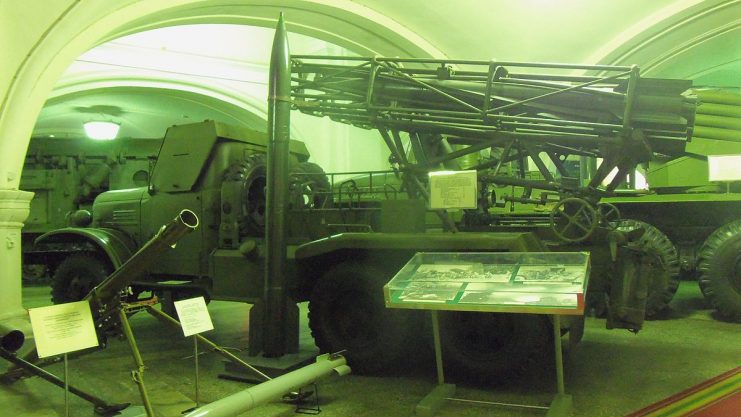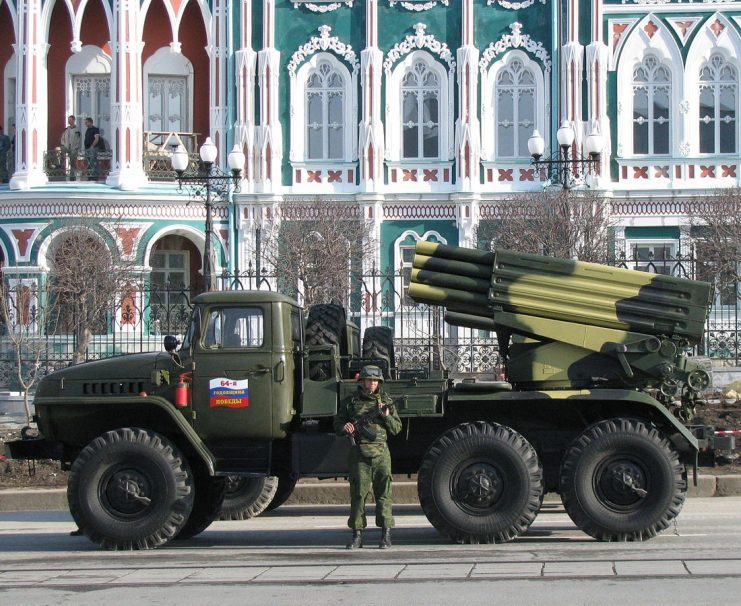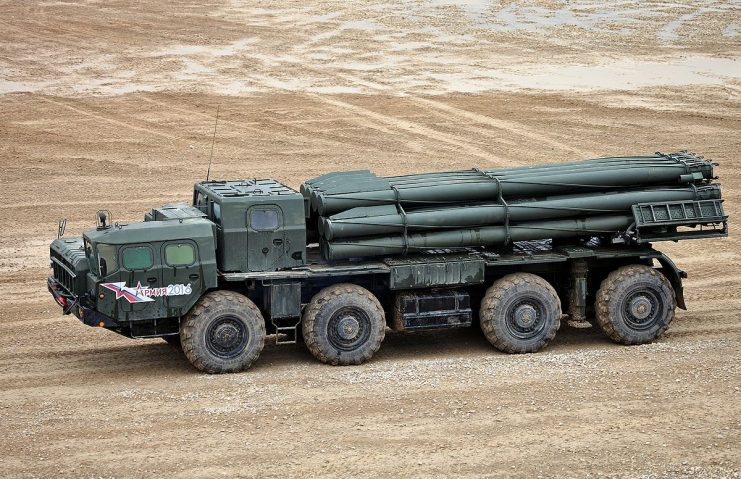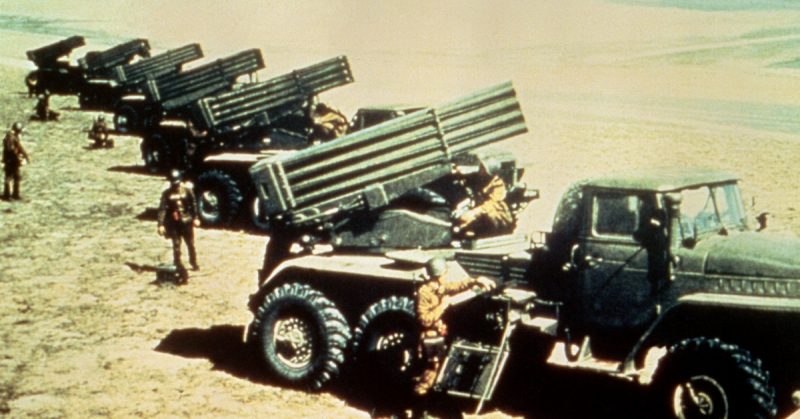Rocketry was an important part of the Warsaw Pact to armies during the Cold War. Having discovered in WWII that multiple rocket launchers (MRLs) were effective and easy to manufacture, the Soviets continued to produce them in the years after the war.
These are ten of the MRLs fielded by the Soviet Union and its Warsaw Pact allies.
BM-24
First fielded by the Soviets in 1951, the BM-24 had a crew of six men. Its elevated launcher carried twelve 240mm rockets, laid out in two rows of six. The original version could fire four types of missiles – high explosive M-24Fs with a range of 6km; lighter, less destructive M-24FUDs with a range of 10.6km; and two different rockets carrying chemical weapons.
Before firing, two jacks were lowered to stabilize the vehicle. The elevation and traverse of the rockets were then operated manually. Steel plates protected the fuel tank and the occupants of the driver’s cab from the blast as the rockets launched.
Later variants of the BM-24 used rockets with a greater range and were also improved for better off-road travel.
BMD-20
Development of the BMD-20 began in 1945 but was held up by changes to the requirements of the weapon. It was finally trialed in 1951 and given to the army in 1952.
The BMD-20 carried four 200mm high explosive rockets which were lighter than the rockets of the BM-24. They had less impact but a greater range, reaching up to 19km. They were mounted in a row across its back.
The BMD-20 had to be stabilized with a jack before firing, and it took ten minutes to reload.

BM-14
In 1952, the BM-13, which had served in WWII, was replaced by the BM-14. The six-wheeled vehicle carried two rows of eight 140mm rockets. It had limited ability to traverse and it, like the elevation, was operated manually. The rockets could be fired by remote control from up to 60m away, providing a safe distance between the operator and the blast of the missiles.
Originally, the BM-14 could fire only high explosive warheads, with a range of nearly 10km. Smoke and chemical options were introduced in 1955.
BM-25
Introduced in 1957, the BM-25 was equipped with six liquid-fuelled 255mm rockets. They had a greater range than previous MRLs, reaching up to 30km.
In preparation for firing, the crew of the BM-25 fitted protective armored shutters across the windscreen and lowered two stabilizers to hold the vehicle in place.
BM-21 Grad
The BM-21 Grad was all about volume of firepower. Its launchers carried 40 relatively small 122mm rockets with a range of just over 20km. To ensure large salvos, it was deployed in battalions of 12 vehicles, which were increased to 18 in times of war. Each Soviet front or army included three of those battalions.
The rockets could be fired either individually, in ripple patterns, or in a single devastating salvo. They initially carried high explosive warheads, with chemical and incendiary options added later.
A lighter 12 rocket version was developed in 1969 for airborne troops. Parts of the vehicle were collapsible to use less space in a transport plane. It had tie-down points enabling it to be lashed to a pallet for a parachute drop.

BM-27 Uragan
Appearing in the mid-1970s, the BM-27 Uragan was also intended for deployment in battalions of 12 or 18 vehicles, grouped together in larger regiments or brigades. Each vehicle carried 16 rockets which could be fired individually or as a salvo.
Each battalion was accompanied by a collection of command and control vehicles which collectively made up the Kapustnik-B fire control system. They had systems for communication, data transfer, location fixing, weather detection, reconnaissance, and missile tracking. Together they provided greater control over massed rocketry.
BM-30 Smerch
The BM-30 had a 12 rocket launcher that could be elevated and rotated readily before firing. It entered service in 1987 alongside its loading vehicle, the 9T234-2 transloader, which carried 12 spare rockets and a hydraulic crane to transfer them onto the BM-30.
By then, each vehicle had its own computers, communications equipment, and automated system for fire control. The course of the rockets could be corrected in flight, making the BM-30 very accurate. It had a range of 70km.

BM 9A51 Prima
The BM 9A51 Prima also appeared in 1987. It used the same chassis as the BM-21 but had more firepower. It carried 50 rockets on an elevating, rotating mount. Like all the vehicles that came before it, it had to be grounded with stabilizers before firing.
The BM 9A51 carried the same 122mm rockets as the BM-21, as well as a new version. It had a warhead that separated from the rocket and then descended on a small parachute. It detonated yards above the ground, its airburst giving it a wider blast radius.
RM-51
A Czech vehicle, the RM-51 went into service in 1956. It carried 32 rockets ready to fire, as well as boxes of spares for reloading. The 130mm rockets had a range of 8.2km.
The RM-51’s cab had no protection against the blast of launching rockets. The launcher, therefore, had to be shifted to one side before firing.
The vehicle was exported to Bulgaria, Cuba, and Egypt. Austria and Romania also used variations of it.
RM-70
Another Czech vehicle, the RM-70 appeared in the early 1970s. It carried the launcher used by the BM-21, as well as a set of 40 spare rockets for fast reloading. Its superior chassis made it better for cross-country travel than the BM-21 and its armored cab protected the crew from shrapnel and small arms fire.
An improved version produced in the 1980s carried the same rocket system on a better chassis. The vehicle lacked the armored cab but had protection from nuclear, biological, and chemical contaminants.
Source:
Russell Phillips (2017), Tanks and Combat Vehicles of the Warsaw Pact
